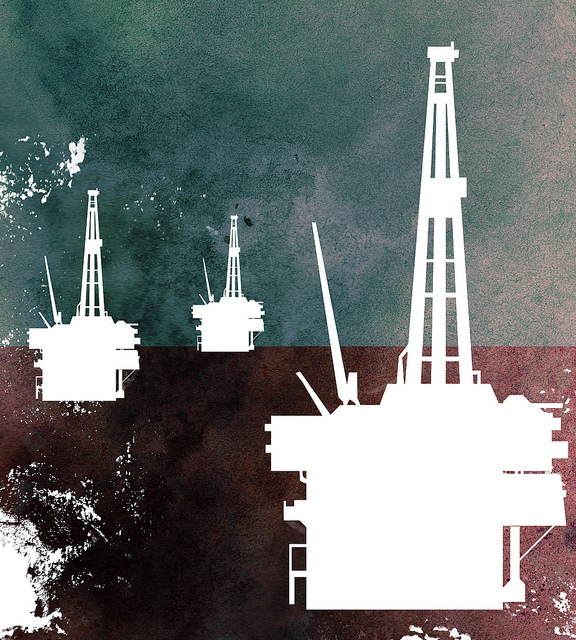Please help rabble.ca stop Harper’s election fraud plan. Become a monthly supporter.
I was cruising the Internet a couple of weeks ago when this headline in the Los Angeles Times made my eyes pop: “U.S. officials cut estimate of recoverable Monterey shale oil by 96 per cent.”
Ninety six per cent! Since the Monterey formation accounts for two-thirds of the supposed reserves available for fracking that would make the U.S. not only energy independent but a powerhouse exporter to the world, this was a big bubble bursting. Amazing that you haven’t heard of it, but such is the tenacity of the world’s built-in resistance to energy reality.
There have been other such downgrades from overblown claims, for both oil and gas, enough that the Paris-based International Energy Agency, which in 2012 declared that the U.S. would overtake Saudi Arabia in oil production by 2020, has admitted that it, too, was fooled. Its prognosis now: the U.S. will import more from Saudi Arabia by 2020 as the fracking boom peaks and declines. So much for the mythical “100-year supply,” thanks to fracking.
In Nova Scotia as elsewhere, as we face vital energy and related economic decisions at every turn, it’s essential that we keep this big-picture stuff in mind.
For one thing, our own fracking debate has echoes of Monterey. A report of the review panel on fracking said 17 trillion to 69 trillion cubic feet of natural gas is available in the Kennetcook-Windsor formation, while a retired government geologist calls this bunk and puts it at a dribble. In the ample history of exaggerated petroleum estimates — where a gold-rush mentality is needed to raise investment money — it’s amazing how often independent geologists have turned out to be right in questioning the big numbers.
Meanwhile, a business consortium is looking for supply to justify building an $8.3-billion liquefied natural gas terminal in Guysborough County.
Don’t count on that happening. As gas replaces oil and coal, North America could end up having little to export.
And the story doesn’t end there. You’d think that if oil is in ever-shortening supply, the price would rise even more, justifying more exploration. At least, that’s what’s endlessly preached by the industry-funded think-tanks.
But several other things are happening. One is that with no more easy stuff to find, exploring and developing new reserves — tar sands, the deep ocean, fracking — are becoming hideously expensive, and oil companies are cutting back, including some recently in the tar sands.
This raises my own niggling question if we ever take to fracking in Nova Scotia: far from bringing us prosperity, we might end up subsidizing it, seeing that we have a notorious fondness for white elephants thinly disguised as soaring eagles.
Indeed, the amount of investment now needed to develop new oil and gas just to keep up with declining conventional reserves is, by some accounts, straining the world financial system. In other words, we can’t afford it anymore.
Also happening is that alternatives, efficiencies and conservation are really taking off worldwide. This is especially so in the world’s sun belt where solar electricity is now competitive without subsidy, and as grid improvements and storage techniques continue developing.
According to some analysts, increasingly the issue is no longer “environmentalists vs. business” but “business vs. business” as alternative energy businesses take on the tottering empires of coal and oil.
And both the United States and China are now clamping down on pollution, especially from coal, leaving reactionary oddballs Stephen Harper and his buddy, Tony Abbott of Australia, virtually alone to make the argument that pollution trumps everything because it pays, meanwhile laughably claiming that they’re leaders in controlling greenhouse gases. As a piece in The Australian, Australia’s national newspaper, proclaimed regarding Abbott’s current visit to Canada: “Harper and Abbott: two fossils fooling no one.”
California is a leader in alternate energy. The promise of endless riches from the Monterey shale was seductive, however, starting a tormented debate about whether that commitment would waver in favour of the easy life with abundant oil, pollution or not.
The message of the downgrade — the oil is there in the deep earth, but in jumbled rocks impossible to extract with today’s technology — is that there’s no easy fossil-fuel route out of the energy crunch, and even if there seems to be one, it’s at the cost of ignoring climate degradation.
Something to take away here in Nova Scotia, if we get tempted by magical thinking, which we always are. The chastened IEA could only call for a renewed and urgent commitment to alternatives, efficiency and conservation. That is the reality.
Ralph Surette is a freelance journalist in Yarmouth County. This article was first published in the Chronicle Herald.
Image: Jared Rodriguez / Truthout




